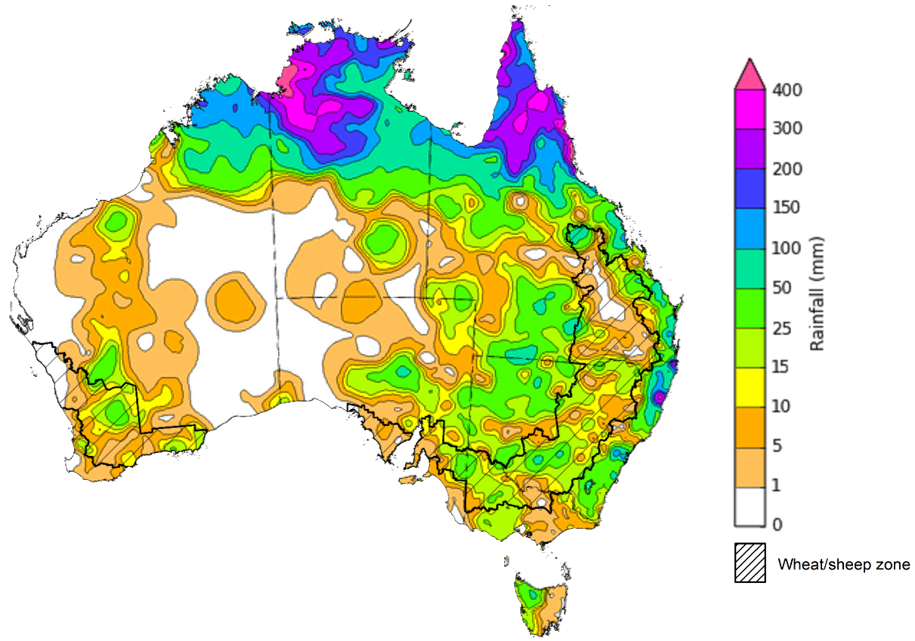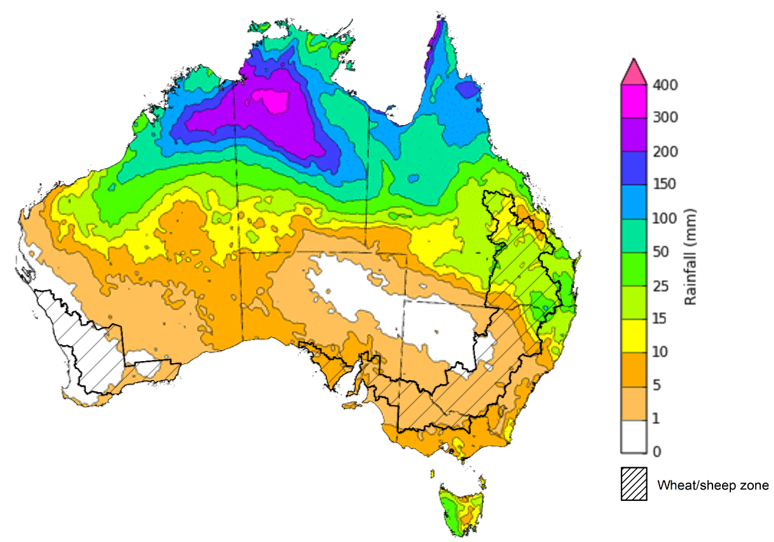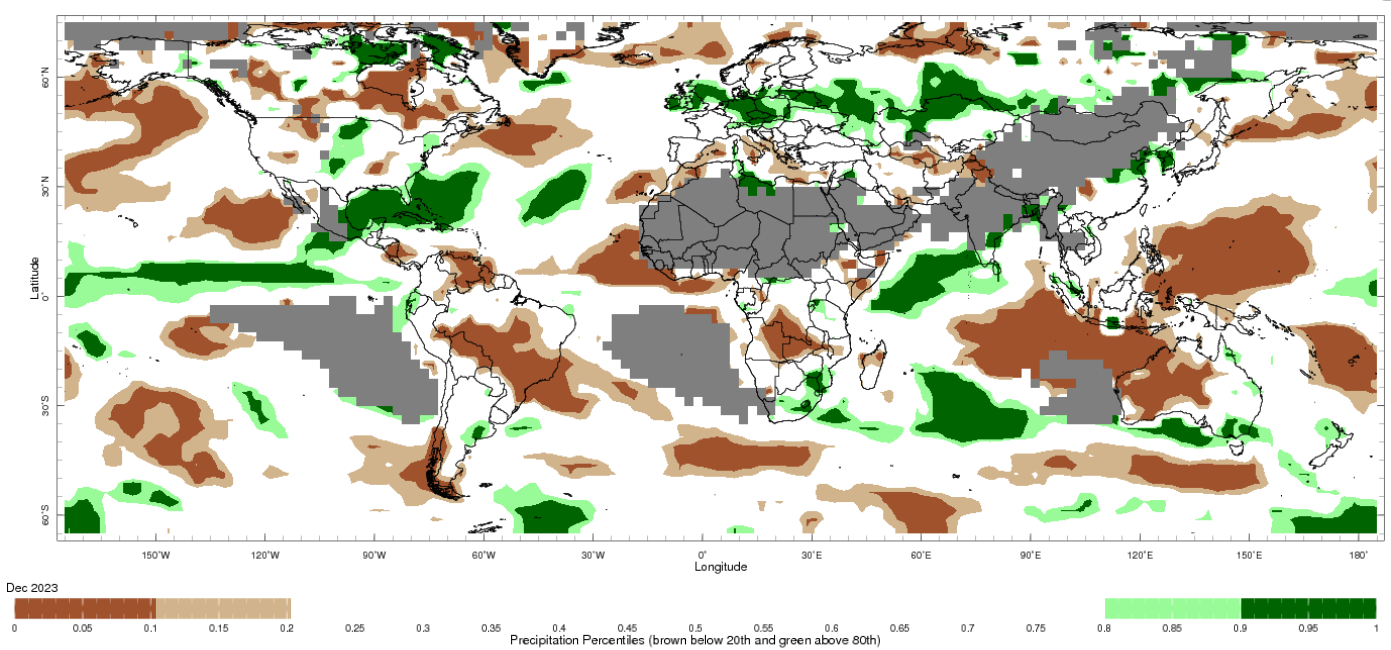Key issues
- For the week ending 17 January 2024, an active monsoon trough combined with a tropical low brought heavy rainfall in tropical parts of the country. Severe thunderstorms brought rainfall to southeast Australia.
- These falls have provided significant boost to the soil moisture to support pasture growth and built reserves ahead of the upcoming winter cropping season.
- Over the coming week, the active monsoon trough and tropical low will continue to bring heavy rain, in excess of 150 millimetres in parts, to far northern Australia. Troughs across eastern Australia will generate showers and storms over Queensland and northeast New South Wales.
- Rainfall where expected will support development of summer crops and pasture growth, but dry conditions elsewhere will see a decline in soil moisture levels.
- In December 2023, rainfall was variable for the world’s major grain-producing and oilseed-producing regions.
- Northern hemisphere received generally average to above average, with exception of some parts of Canada and the United States where rainfall was below average.
- Southern hemisphere rainfall was below average for southern half of Brazil and northern Paraguay, and across much of western half of Australia. Above average rainfall was recorded for eastern Argentina and south-eastern Australia. Close to average rainfall across the remainder of major grain-producing and oilseed-producing regions.
- February to April 2024 rainfall is expected to be average to above average and snowpack will prevent winterkill in the northern hemisphere grain and oilseed growing regions. Generally average rainfall is expected in southern hemisphere cropping regions.
- Water storage levels in the Murray-Darling Basin (MDB) decreased between 11 January 2024 and 18 January 2024 by 66 gigalitres (GL). Current volume of water held in storage is 19 108 GL. This is 12 percent or 2702 GL less than at the same time last year.
- Allocation prices in the Victorian Murray below the Barmah Choke decreased from $60 on 11 January 2024 to $41 on 18 January 2024. Prices are lower in regions above the Barmah choke due to the binding of the Barmah choke trade constraint.
Climate
For the week ending 17 January 2024, a broad band of cloud and severe thunderstorms, associated with a low-pressure system, moved across south-eastern Australia bringing significant rainfall. An active monsoon trough combined with a tropical low brought rainfall in excess of 200 millimetres in tropical parts of the country.
Across cropping regions, rainfall totals of up to 100 millimetres were recorded in New South Wales, Victoria and in parts of Queensland. Meanwhile, falls of up to 50 millimetres were recorded in parts of South Australia and Western Australia. These falls will support the ongoing growth and lift the yield potential of summer crops across eastern Australia. Additionally, these falls have provided significant boost to the soil moisture to support pasture growth and built reserves ahead of the upcoming winter cropping season.
Rainfall for the week ending 17 January 2024
Issued: 17/01/2024
Note: The rainfall analyses and associated maps utilise data contained in the Bureau of Meteorology climate database, the Australian Data Archive for Meteorology (ADAM). The analyses are initially produced automatically from real-time data with limited quality control. They are intended to provide a general overview of rainfall across Australia as quickly as possible after the observations are received. For further information go to http://www.bom.gov.au/climate/rainfall/
Over the 8 days to 25 January 2024, the active monsoon trough and tropical low will continue to bring heavy rain, in excess of 150 millimetres, to northern parts of the country. Troughs across eastern Australia will generate showers and storms over Queensland and northeast New South Wales. A low-pressure system will generate heavy falls in Tasmania.
Across cropping regions, rainfall totals up to 50 millimetres are forecast for Queensland and northern New South Wales. These falls will benefit soil moisture levels for pasture growth and support summer crops. Little to no rainfall is expected across remaining summer cropping regions.
Total forecast rainfall for the period 18 January 2024 to 25 January 2024
Issued 18/01/2024
Note: This rainfall forecast is produced from computer models. As the model outputs are not altered by weather forecasters, it is important to check local forecasts and warnings issued by the Bureau of Meteorology.
Crop production is affected by long-term trends in average rainfall and temperature, interannual climate variability, shocks during specific growth stages, and extreme weather events. Some crops are more tolerant than others to certain types of stresses, and at each growth stage, different types of stresses affect each crop species in different ways.
The precipitation anomalies and outlooks presented here give an indication of the current and future state of production conditions for the major grain and oilseed producing countries which are responsible for over 80% of global production. This is an important input to assessing the global grain supply outlook.
December precipitation percentiles and current production conditions
As of the end of December 2023, rainfall was variable for the world’s major grain-producing and oilseed-producing regions.
In the northern hemisphere, precipitation was generally average to above average, with exception of some parts of Canada and the United States where precipitation was below average.
In the southern hemisphere, December precipitation was below average for southern half of Brazil and northern Paraguay, and across much of western half of Australia. Above average precipitation was recorded for eastern Argentina and south-eastern Australia. Precipitation was close to average across the remainder of major grain-producing and oilseed-producing regions.
Global precipitation percentiles, December 2023
The global climate outlook for February to April 2024 indicates that variable rainfall conditions are expected for the world's major grain-producing and oilseed-producing regions. Outlooks and potential production impacts for the major grain and oilseed producing countries are presented in the table.
Rainfall outlook and potential impact on the future state of production conditions between February to April 2024
| Region | February to April rainfall outlook | Potential impact on production |
|---|---|---|
| Argentina | Generally average rainfall is likely across much of Argentina with an exception in eastern areas where below average rainfall is likely. | Average rainfall is likely to support flowering of soybeans, sorghum, rice, and millet in the February and increase yield potentials of those crops. |
| Black Sea Region | Average rainfall is likely for Turkey, Kazakhstan, Ukraine and Russian Federation. | The average rainfall conditions are likely to support the development of winter wheat and canola, and planting of corn, cotton and sunflower across Russia. |
| Brazil | Average rainfall is expected across southern half of Brazil. | Average rainfall will benefit the development of soybeans, cotton, rice, sorghum, millet, sunflower, peanuts, and corn prior to the harvesting of some crops beginning in March 2024. |
| Canada | Generally average rainfall is likely with exception in isolated areas in central areas where below average rainfall is likely. | Through to March, winter wheat and canola will progress from dormant to heading. Average rainfall will likely provide sufficient snowpack to prevent winterkill of winter wheat and canola and support vegetative growth and heading. |
| China | Average to above average rainfall is expected across China. | Through January and February, winter wheat and canola will remain dormant. Average to above average rainfall may minimise the risk of winterkill through snowpack during winter. |
| Europe | Average rainfall is likely for most of Europe. | Average rainfall may support snowpack, minimising the risk of winterkill for winter wheat and canola. Average rainfall in southern Europe should provide favourable conditions for winter wheat. |
| South Asia (India) | Above average rainfall is expected in far northern areas while average rainfall is expected across the rest of India. | Average rainfall across much of India may support vegetative growth and heading of winter wheat and canola between January and February. In the far south, winter crops would be expected to benefit from average rainfall. |
| Southeast Asia (SEA) | Above average rainfall is likely across much of SEA. | Above average rainfall in SEA likely supports vegetative growth for corn and rice throughout January to February. However, excessive rainfall may result in flooding and crop damage. |
| The United States of America | Above average rainfall is more likely for the southeastern areas, below average rainfall in southern areas and average rainfall across rest of the United States. | Average rainfall through winter is expected to protect wheat and canola through dormancy. Below average rainfall may adversely impact crop development and planting in the southern areas. |
Water
Water storages, water markets and water allocations - current week
The Tableau dashboard may not meet accessibility requirements. For information about the contents of these dashboards contact ABARES.
Commodities
Information on weekly price changes in agricultural commodities is now available at the Weekly commodity price update.



